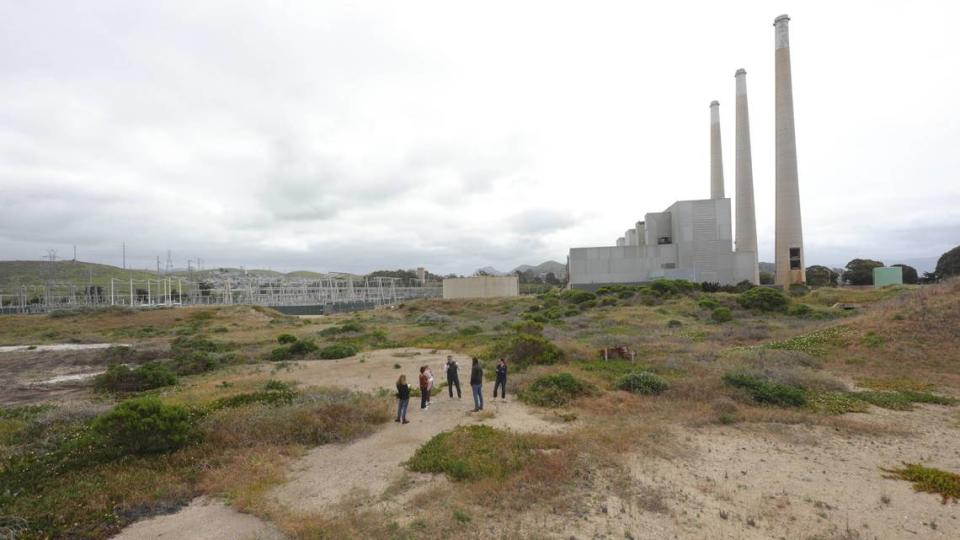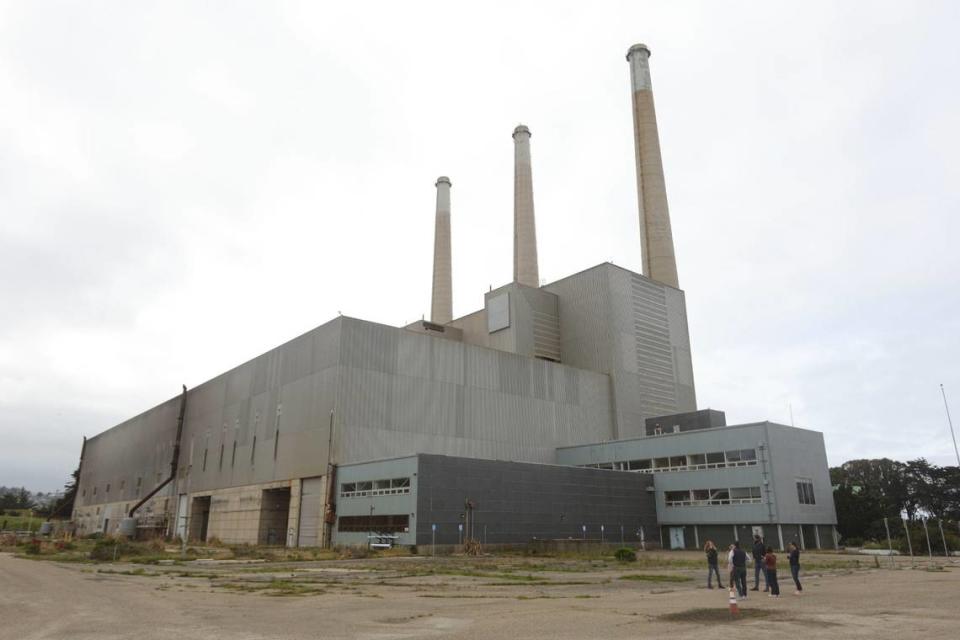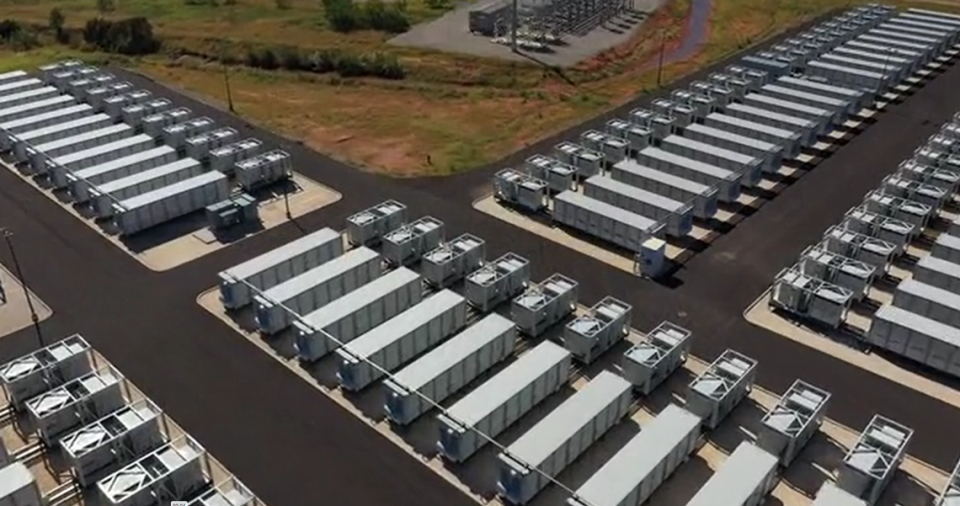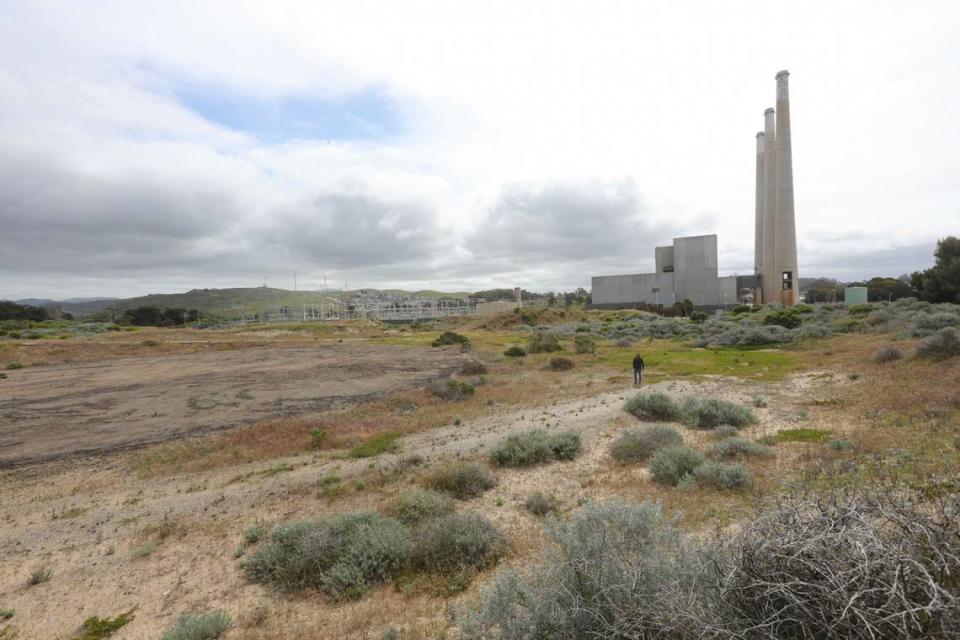Report says Morro Bay battery plant won’t harm the public or wildlife. Residents disagree
Building a battery plant on the retired Morro Bay Power Plant property would have a minimal impact on the environment or public safety, according to a report prepared by the city — but a group of citizens still worry about the the project.
On Tuesday evening, the Morro Bay Planning Commission held a workshop for the public to comment on the draft environmental impact report, prepared by city staff and Rincon Consultants.
Texas-based energy company Vistra Corp. applied to build a 600-megawatt battery plant on a 24-acre piece of the power plant property.
The project also includes the demolition of the Morro Bay Power Plant and its three stacks, along with the preparation of a master plan to guide development on the rest of the 107-acre property.
The Morro Bay City Council and California Coastal Commission will eventually vote on whether or not to approve the project.
About 40 people attended the meeting on Tuesday, many who wore bright blue “Save Estero Bay” T-shirts and spoke against the project.
Last year, a community group called Citizens for Estero Bay Preservation recruited more than 1,000 registered voters in Morro Bay to sign a petition supporting a ballot measure designed to block the battery plant. That measure will be on the ballot for Morro Bay voters in November.
The public can submit written comments to the city on the draft report until May 28.
Email comments can be sent to BESScomments@morrobayca.gov and letters to 955 Shasta Ave., Morro Bay CA 93442.
The city will answer the community’s questions in the final environmental impact report, which will be released later this year.

Battery plant only has one significant impact, report said
The project’s only “significant and unavoidable” impact is removing a historical resource — the decades-old power plant and stacks, which is recognized for its engineering and architecture, according to the draft environmental impact report.
To mitigate the loss, Vistra would need to submit high-resolution digital photos, a historical report and compilation of historic research on the power plant to the Historic American Engineering Record, the Historical Society of Morro Bay, the History Center of San Luis Obispo County, the city of Morro Bay and the Morro Bay Library.
Otherwise, mitigation efforts would reduce impacts to wildlife and cultural resources to “less than significant,” the report said.
To mitigate potential impacts to wildlife, Vistra said it would pay a city-approved biologist to survey the project site and relocate sensitive species, train construction workers and prepare a habitat mitigation and monitoring plan, the report said.
Additionally, a biologist, an archaeologist and a Native American observer would oversee construction with the authority to halt or redirect work to relocate sensitive species or investigate artifacts found on the property.

Morro Bay residents question environmental impact report
A few speakers at public comment questioned the validity of the environmental impact report, as Vistra hadn’t yet settled on an official project design.
Vistra’s original application proposed to build three Costco-warehouse-sized buildings that each hold 200 megawatts of battery storage.
In the draft environmental impact report, Vistra also offered five alternative project designs, including a facility that houses batteries in 174 individual enclosures that each store 3.5 megawatts of electricity.
Vistra might use lithium ion batteries, but the company will choose the best technology available when construction begins, according to Vistra project development director David Yeager.
The city of Morro Bay will ultimately pick the final project design.

Morro Bay resident Steve Ray said the city should wait for a “specific and precise project” before evaluating it.
“The applicant has indicated that they have not decided on what project they’re going to build,” Ray said. “They don’t know what batteries they’re going to use, they don’t know what chemicals are going to be involved in those batteries to do any chemical analysis and any risk assessment to the public — all of those things are undecided.”
Most of all, speakers at public comment said they were concerned with the safety of the battery plant.
Cayucos resident Rachel Wilson feared that nearby residents couldn’t escape their neighborhood during an emergency at the battery plant, she said.
When she attended Morro Bay’s annual Kite Festival in April, traffic was so bad that she spent an hour waiting to exit the Morro Rock parking lot, and another hour and 45 minutes to drive to the Beach Street intersection on the Embarcadero.
During peak periods, she argued that nearby residents and tourists wouldn’t be able to safely evacuate the area during an emergency.
“On that two-lane road, Coleman Drive, there is not a significant, quick, and effective way to get out of there,” Wilson said.

The plant would be built in a state-designated Tsunami Hazard Area. Even so, the environmental impact report said tsunami danger is low for the facility. The sand spit, the narrow harbor and Morro Rock would absorb much of the impact of a tsunami, and 30-foot-tall berms surrounding coastal-facing sides of the project site would protect the plant, the report said.
Fire walls and battery monitoring systems would prevent fires from starting and spreading at the plant, the report said. Additionally, a safety study commissioned by Vistra said that a large fire at the facility would not release enough toxins to harm public health.
The city hired Delaware-based DNV Energy USA Inc. to fact-check that safety report, according to interim community development director Micheal Codron.
Longtime Morro Bay resident Joyce Hunter said she didn’t think either report adequately evaluated the worst possible natural disaster. She suggested that the final environmental impact report analyze the effects of a tsunami large enough to breach the berms and flood the battery plant. She also wanted to know the impact of a fire that spread across the entire plant.
“We need to be told what the worst-case scenario is,” Hunter said. “We don’t control Mother Nature. We don’t control the elements.”
Morro Bay resident Pam Dougherty said she supports renewable energy, but she opposes locating the facility next to a federally recognized estuary.
“I feel like the report didn’t really adequately address the years and time and effort spent to restore a once-fragile estuary and the sensitive species that inhabit this area,” Dougherty said. “I’m concerned that we will undo some of this important work.”
Overall, Dougherty said she doesn’t trust Vistra to prioritize the health of the environment and the community while building and managing the battery plant.
“Vistra, really, when it comes down to it, is a company that wants to profit from renewable energy,” Dougherty said at public comment. “They don’t really have an interest in the community beyond connection to the power grid. In my mind, the easiest mitigation is just to stop the planning and keep our community and wildlife safe.”
Other residents, however, think the city should work with Vistra to design an acceptable project.
Morro Bay resident Carol Swain said the impacts of climate change outweigh concerns over the battery plant.
More renewable energy facilities must be built in California to keep up with the state’s increasing demands for electricity, Swain said. She said it makes more sense to build the battery plant on polluted land, like the Morro Bay Power Plant site, than on undeveloped land, where the project would have more environmental impacts.
She said the city should find ways to compromise with Vistra and allow the project to move forward.
“We all love Morro Bay,” Swain told The Tribune after the meeting. “But the battery plant is something that we just might have to accept as payment for realizing our goal of a cleaner environment and cleaner energy.”

